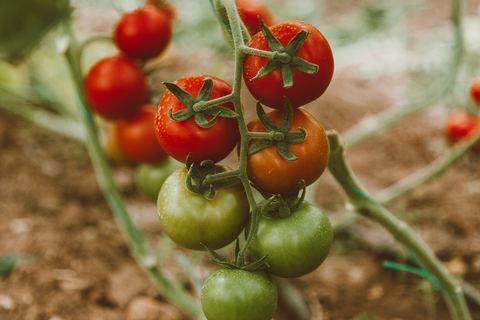Looking After Tomatoes
Tomatoes, or Lycopersicum Esculentum, have been cultivated for thousands of years and are native to the Andean region of South America. They were first grown in Peru in the sixteenth century. They were exposed to European civilizations by the Spanish. Untill the end of the sixteenth century, Europeans were reluctant to eat tomatoes since they were thought to be deadly because they were a member of the nightshade family. Later, the French gave them a try and started referring to them as "pommes d'amour," or "apples of love." They believed tomatoes to have aphrodisiac properties. In North America, the tomato didn't become widely used until the 1900s.
Scientific studies demonstrate this delectable fruit's advantages for your health. In recent years, scientists learned that lycopene may be found naturally in foods like tomatoes. Tests have demonstrated that this antioxidant significantly lowers the risk of heart disease and a variety of malignancies, including prostate and colon cancer. With almost little fat or salt, tomatoes are a great source of phytochemicals, minerals, and fibre. They provide considerable amounts of iron, potassium, and the vitamins A, B, and C. In actuality, 20% of the daily recommended amount of vitamin A and 40% of the daily recommended value of vitamin C are each present in one medium-sized tomato.

How to Adapt
Growing tomatoes from seed is really simple. There are more than 100 different varieties of tomatoes in all. Although the majority of people assume mature tomatoes are red, they can also be green, yellow, purple, or even striped. You won't be able to sample the various varieties unless you grow your own. Purchase tomato plants from garden centres if you lack the time. As they are becoming more widely available from farmers, look for different types.
Plant tomato seeds in a seedling flat and fill it with a high-quality seedling mixture six to eight weeks before transplanting. Make sure the soil is sterilised, has a high percentage of sphagnum peat moss, and perlite by using a high-quality potting soil from the garden centre. Avoid using garden soil since it has a tendency to become hard and prevents seedlings from taking root properly. It may also include insects, disease, weed seeds, or pesticide residue.

Seeds should only be sown as deeply as their thickness; scatter them upon the soil-filled flat and lightly press them down. To keep the seeds from drying out, cover them with a thin layer of fine, horticultural-grade vermiculite. Just enough water is used to spritz the soil with a fine mist using a mister bottle or the sprayer on the kitchen sink. Keep the seeds uniformly moist to prevent the mixture from drying out, as both germination seeds and seedlings are extremely sensitive to dry soil and will perish if it is. Put plastic wrap or a transparent plastic bag over the flat or pot. As soon as the seedlings appear, take the plastic off.
Each container should be marked with the tomato type and the planting date. Place them flat on a hot table, the top of the refrigerator, or a heat register to encourage quick germination. Move them away from the heat source and into a bright area as soon as they germinate and start to sprout seedlings. To develop effectively, they require extremely high light levels, thus a south-facing window without blinds or curtains is best. To promote growth, use grow lights. Lights should be hung 6 inches (15 cm) from plants and left on for 14 hours each day.

When the seedlings develop their first "real" leaves, transplant them into larger, individual containers. After transplanting, treat once a week at 1/4 strength with a plant-starter fertiliser. They are weekly nourished until they are taken outside and are strong, healthy plants. Harden them off and bury them deeply where the stems will grow roots to support the establishment of the plant.
Because they use a lot of food, tomatoes require a lot of compost or decomposed manure. Maintain soil moisture and ward against rot and wilt disease by mulching and watering in dry weather. Calcium shortage or water stress are the two main causes of blossom-end rot. Blossom-end rot is a problem that can be avoided by providing regular, balanced watering. Always water tomatoes from the bottom up. Deeply irrigate tomatoes from below.
We have a wide range of products for growing selected vegetables, included top brands for tomatoes. Click here to shop the tomato range.

Tomatoes combine well with chives, onion, parsley, marigold, nasturtium, and carrot in the garden. All Brassica family members and tomatoes should be kept away since they are antagonistic to one another. To keep tomato plants free of red spider mites, interseed garlic between them. Roses will be shielded from black spots by tomatoes. Use tomato leaves in your vegetable juicer along with 4 or 5 pints of water and 1 tablespoon of cornstarch to create a spray for roses. When planting tomatoes as companions is not practical, strain the water and spray it on the roses. Any unused spray should be labelled and stored in the fridge.
Tomatoes can be used in the kitchen for salads, soups, juices, sauces, stews, sandwiches, filled foods, grilling, broiling, pasta dishes, and salsa. They pair well with other vegetables, pasta, rice, fish, poultry, and meat. At room temperature, keep tomatoes. Green tomatoes can be allowed to ripen for a few days at room temperature in a brown paper bag with an apple. Use canned tomatoes or canned tomato juice as acceptable replacements if fresh tomatoes aren't available.